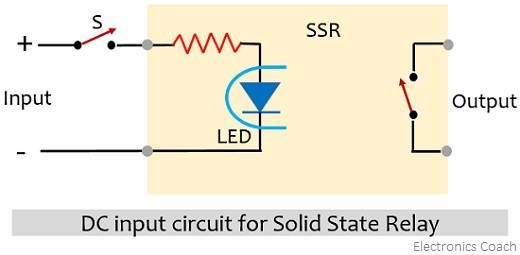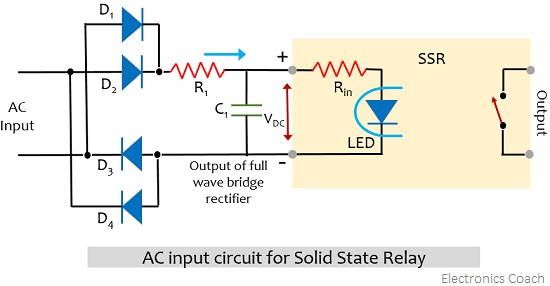Solid State Relay also known as Solid State Switch is an electronic device used for switching the load on and off when the external supply voltage is provided across the input terminals of the device. It is abbreviated as SSR.
These are basically semiconductor devices used to control the load thus these devices use electrical properties of solid-state semiconductors like transistors, MOSFET, TRIAC, etc. to execute input and output switching operations.
What are Relays?
Relay is basically a device that forms electrical interconnection between two or even more points when some external control signal is provided at its input terminals. In relays, a low-level control signal is switched to a high level with the help of various contact arrangements. The output of the relay is further used to drive or operate another physical electrical process.
Electrical relays are mainly classified into two categories. One is Electromechanical Relays (EMR) that basically possess mechanical action. While the other is solid state relays (SSR) that uses the devices like transistors, thyristors, etc. for the purpose of switching action.
We have discussed in the beginning that relays are used as switching devices. So, the question arises that why are we not using switches to control the turning on and turning off operations of devices. But the major drawback of switches is that they need manual assistance whenever needed to be on or off. While relays are operated electrically and when used for high current switching applications these are sometimes referred as contactors.
Comparison between Electromechanical and Solid State Relay
Earlier the protective relays were electromechanical devices that have various moving parts and utilized electromagnets for the purpose of opening or closing the contacts between the various parts of the relay. This was reliable and offered easy operation.
But with the advent of technology, solid state relays came into existence that use the semiconductor properties to maintain the required contact so as to have desired switching characteristics. Solid State relays are advantageous over electromechanical relays due to various factors.
Unlike, electromechanical relays that have moving parts, solid state relays are static in nature thus have inbuilt components like transistors, diodes, capacitors, etc. The comparison and measurement are done by the static circuits thus have no moving parts. So, the absence of moving machinery in solid state relays makes it suitable for the long run as the chances of wear and tear during operation are negligible.
Electromechanical relays act on supplied input energy while solid state relays operate on control signals supplied in the form of voltage or current.
The accuracy offered by solid state relay is comparatively more than that of the electromagnetic relay. Also, electromagnetic relays are heavy and bulky while SSRs are comparatively lighter.
Working of Solid State Relay
We know that a solid state relay uses the behavioral characteristics of a solid-state semiconductor to execute input and output switching operations. Here in SSR, complete isolation between input and output contacts is maintained. The output behaves as an electrical switch offering infinite resistance when open and low resistance when closed.
In SSR, the low voltage input is electrically isolated from the output and the output is used for purpose of switching and controlling the load.
Let us now understand how this is achieved:
The optocoupler or optoisolator is a crucial element for solid state relays as it is used to isolate input from the output. It consists of a source of light generally LED that forms interconnection with the input drive section of the solid state relay. But as we know that it operates in a contactless manner thus, the light emitted from the source provides optical coupling to the photosensitive transistor or TRIAC.
This happens in a way that when an external current is provided then the source of light is illuminated and its illumination is focussed across the gap towards the phototransistor. This low voltage signal excites the output of the SSR and with the use of an optoisolator, proper input and output isolation is maintained. Thus, with the use of a proper control signal, solid state relay gets turned on and off. While in case any unwanted situation occurs during the operation then cut-off function is executed that is initially installed.
It is to be noted here that the voltage used to enable conduction in the solid state relay which is to be applied at its input terminal must be essentially greater than a minimum value of about 3V DC. The DC input supplied to the SSR can be taken from a mechanically operated switch. While in the case of AC input, the required supply voltage lies between 90 to 280 V. And a standard DC solid state relay can be controlled with AC supply using a bridge rectifier and capacitor configuration. 
The output circuit of the solid state relay can be selected as AC or DC depending on the type of input circuit. Generally, the output configuration suits only one type of switching action. In DC circuits, transistors or MOSFETs are used as switching devices but in AC circuits, thyristors or TRIACS are used. For the purpose of interfacing, the output of solid state relays is provided to a computer.
Advantages
- The chances of noise pollution are almost negligible due to the absence of direct contact with moving parts.
- SSRs offer faster switching time than EMR.
- It shows less sensitivity towards external factors like shock, vibration, and magnetic fields, etc.
- Solid state relays offer long run use as there is no contact moving parts thus less susceptible to wear and tear of the machinery.
- The output resistance remains constant even after multiple uses.
Disadvantages
- It offers non-linear voltage-current characteristics.
- Sometimes voltage transients result in spurious switching.
- For the gate charging circuit there exist a requirement for the isolated bias supply.
- Sometimes its output exhibit polarity sensitive nature.
Applications of Solid State Relays
It is used for switching AC loads, as it offers easy controlling of AC loads with low-value DC voltage. Various household circuits use solid state relays for load switching of AC loads. Also, these are used in power controlling and heater control applications.
Leave a Reply